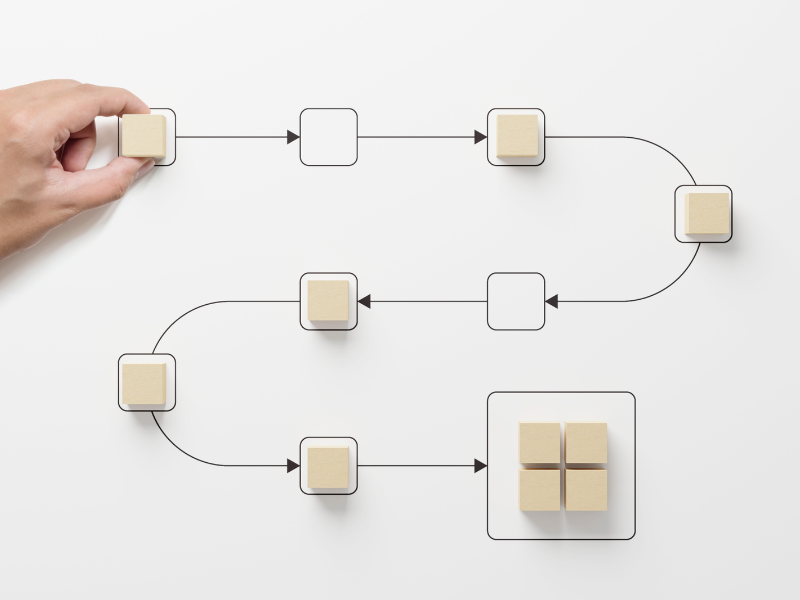This article contains affiliate links – but that doesn’t mean this piece is an ad.
All content is our honest take on the service/product and incorporates our
real thoughts and experience using it.
What’s the difference between a startup and a $100 million ARR company? Their products? Connections? Executives and leadership team?
Those can certainly play a part, but I’d say the biggest difference is their emphasis on implementing processes and systems.
As a startup, the primary focus is to get an MVP up and running, test it, get market validation, fine-tune, and then scale.
The issue? Limited resources. There’s never enough cash, labor, or time in the day to do everything, so it’s constantly a scramble. In the end, it seems like you’re just treading water to stay alive rather than swimming ahead and making progress.
On the other hand, a well-established company has people in place to do specific jobs. It has a standard operating procedure (SOP) on how to deal with specific situations. And most importantly, it understands what is needed for success (e.g. if we do this, we can expect X results). This is how it can create systems that can provide consistent and replicable results.
Building and implementing these processes is one of the most impactful things startups and >$50 million ARR companies can do. That’s why as a CMO, one of my biggest priorities is providing systemization and frameworks based on whatever data I can get my hands on. Those systems can then live on, providing consistent results even when I’m gone.
“But big companies have the time and budget to build processes. Startups don’t.” That’s true to an extent, but those companies got to $100m+ because of their processes. Not because they built them afterward.
In fact, the earlier you start building processes, the easier the road will be. Let me show you how…
Table of Contents
Building Processes and Systems as a Startup

First off, when I talk about processes, I am talking about a collection of actions that get a certain result when done in the right way. Here’s an example:
Result – Sell 100 items within a month
Data – On average, I have a 5% email conversion rate
Team – Me
Based on my data, I need to engage 2,000 people in order to hit my goal of 100 sales. That means I have to send 100 emails every workday to hit my quota. The process itself is pretty simple thanks to some email automation tools like Apollo or Dripify. In fact, I could get the whole thing up and running myself in no time.
But this is where we want to pause and think about the process itself. While I might be the one managing email marketing now today, the ultimate goal is to hand it off to someone else so I can free up time to focus on other aspects.
So while you go through these processes, document what it takes and see how you can make it easier to offload it to someone else (eventually).
It’s going to look something like this:
- Build an email list (collect emails from our internal list, or utilize a tool like apollo.io to generate one)
- Clean the email list (run it through a verification tool to minimize the emails that bounce)
- Upload the email list to the email automation tool
- Set up the campaign
- Do we need to write new emails or use the previous ones?
- Did we learn anything from the previous campaign that could help fine-tune and improve this one?
- Plan email chains and intervals
- Launch email campaign
Building a list like this provides a step-by-step process for how something was actually done. This is very beneficial because:
- You documented how you did it, so you know what to do the next time (or what needs to improve)
- You could hand this list off to a new hire and they would have solid information on how to do the job.
It also provides a great baseline that can be iterated over and fine-tuned. Are you scaling faster than you thought? Well, maybe the process has to be adjusted to accommodate that. Maybe there is another step we have to add in order to double the emails sent.
This doesn’t add a massive amount of work to your plate, and it definitely makes your life easier down the road. Not to mention, it provides a clear structure on how to obtain specific results. And that gets you one step closer to becoming a $100m+ company.
Processes and Systems = Replicable Results

One of the biggest challenges startups and small companies face is consistency. Creating processes is the key to solving that, and it doesn’t just have to apply to marketing. Systems are a key part of every aspect of the company — sales, operations, management, the whole thing.
It won’t happen overnight, but building processes as you build your company will simplify things considerably in the near and far future, and it will put you ahead of 90% of your competitors as they are forced to tread water instead of making real progress.




